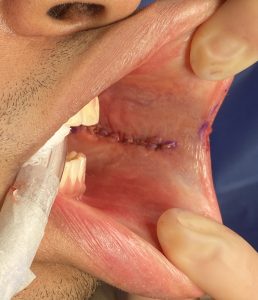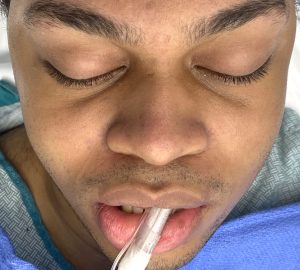Background: Reductive soft tissue cheek procedures historically consist of the well known buccal lipectomy. While commonly performed its anatomic location and the extent of its effect on the midface is often under appreciated. When taken in the context of the trampoline concept of the midface, the buccal lipectomy is not a comprehensive cheek thinning/reductive procedure.
The trampoline concept of the midface refers to the unsupported soft tissues of the midface. Located between the horizontal cheekbones (main body and arch) and the jawline this is the midface area in which the intervening soft tissues are suspended between these bony lines…much like a trampoline. There is no underlying bony support and thus the shape of the ‘cheeks’ is controlled by the thickness of the soft tissues. The buccal fat pad does provide some fullness/support to the cheek area but it is in the upper half of the soft tissue cheek area . Its effect does not extend all the way down to the jawline.
For this reason perioral liposuction is done with buccal lipectomies for a complete midface soft tissue reductive effect. The buccal fat pad does not extend that far down onto the lower cheek area. Subcutaneous fat removal in the lower cheek area helps decrease fullness by the side of the mouth. But there is another cheek soft tissue reduction procedure that is even less well known than perioral liposuction…an internal procedure known as a buccinator mucosal myectomy.
Case Study: This male had a rounded face and had full cheeks. He had modest natural cheek projection but did not desire any cheekbone augmentation.



The buccinator mucosomyectomy tackles the lower inner aspect of the cheek as a third level soft tissue cheek contouring effort. The concept is borrowed from two other procedures, one aesthetic and the other medically indicated. By thinning out the inner cheek tissues it is some similar to how cheek dimples are created although not with the same profound effect. Having done hundreds of buccal mucosal graft harvests for the urologists for urethral reconstruction in an almost identical fashion I have never seen any adverse functional issues with the graft harvest. (which are much longer and wider and they seem to have a slight cheek thinning effect) Thus it seems logical to apply this concept for aesthetic soft tissue cheek reductions in which it is hard, no matter what you do, to every achieve as much result as most patients would like.
Case Highlights:
1) Soft tissue reduction contouring of the face is restricted to the trampoline area between the cheeks and the jawline.
2) Soft tissue derounding of the face usually is achieved by liposuction or direct fat removal. (buccal lipectomy)
3) An intraoral soft tissue facial reduction procedure is the buccinator myectomy which removes mucosa, fat and muscle to complement other cheek defatting procedures.
Dr. Barry Eppley
World-Renowned Plastic Surgeon






